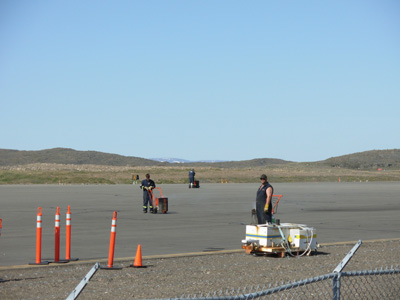
Features
Operations
On Final: Filling in the cracks
The Canadian Arctic is facing a host of environmental problems – not only is it highly vulnerable to the impacts of the warming climate, but it also has a very low adaptive capacity.
November 3, 2010 By Dirk Septer
The Canadian Arctic is facing a host of environmental problems – not only is it highly vulnerable to the impacts of the warming climate, but it also has a very low adaptive capacity. Weather extremes are becoming more frequent and intense. In January 2008, for example, due to a seven-day blizzard, airports in the Kivalliq Region of Nunavut had to shut down, and store shelves in three communities were left bare. With climate becoming more variable and extreme, communities and the infrastructure upon which they rely are increasingly vulnerable. Of particular concern to infrastructure are changes in permafrost, the frequency and severity of extreme weather events, precipitation, the coastal environment and ultraviolet radiation levels. Ultraviolet-induced deterioration, due to significant ozone depletion and long hours of sunlight in summer, has been observed in the Arctic and is only expected to increase.
 |
|
The melting permafrost will affect the integrity of many structures in the north. Anything built on permafrost, including roads, pipelines and underground fuel storage tanks, airport runways and radio towers is endangered. In 2003, a large hole was discovered in the asphalt of Iqaluit’s airstrip, raising future concerns about the stability of the underlying permafrost. Recent reports from the Conference Board of Canada, the Territorial Government, and Nunavut’s chief fire marshal point to an increasingly decrepit infrastructure in the Arctic, including its airports. For Nunavut communities, where the only way in and out is by airplane, only two of these airports have paved runways and many of these airstrips are nearing the end of their useful life. Nunavut’s capital Iqaluit alone needs an estimated $40 million in upgrades.
The impact of global warming is also measured by an increased use of gravel and especially runway de-icer at airports North of Sixty. Warmer winters also increase the use of chemicals used to de-ice aircraft and the runway. A few winters ago, the maintenance people had to apply a lot more potassium acetate than usual and actually ran out. The additional material that is normally brought in by ship on the annual Sealift now had to be flown in at a huge expense. According to one report, to cope with freezing rain that used to fall as snow, 10 times more of these materials are now used. By early January 2010, airport maintenance crews had already used two winters worth of de-icer.
But what really troubles John Graham who manages the Iqaluit Airport, is how the warmer winter weather is going to affect the airport’s reputation as the ideal site for cold weather testing programs for aircraft manufacturers worldwide. With average January and February temperatures of –27 C, Iqaluit’s excellent reputation as the ideal location for such test programs, including the three already scheduled for this winter, may be at risk.
On Jan. 6, 2010, the Canadian Broadcasting Corporation reported, “Mild winter temperatures in Iqaluit are wreaking havoc at the local airport, which not only has to worry about ice-slicked runways, but also its reputation as an Arctic testing ground for aircraft.” If every dark cloud has a silver lining, aviation may eventually also benefit from global warming. Ice roads have been the lifeblood of many northern communities and mines. The cost of building all-weather roads to these remote places may become too high. Moving freight by truck in winter may soon be a thing of the past, opening new opportunities for the general aviation industry. The required construction materials and heavy equipment may now have to be airlifted year round by fixed wing transports and heavy-lift helicopters. In 2006, for example, the Diavik Diamond Mine was forced to use a large helicopter to airlift stranded heavy equipment to its mine some 300 kilometres northwest of Yellowknife. The idea of using blimps to transport passengers and cargo to remote northern locations may also become a cheap and convenient alternative. These giant airships are not only environmentally friendly but would not require the construction of airstrips at places like temporary exploration camps.
Our Arctic infrastructure is becoming increasingly vulnerable to the effects of global warming. Problems associated with the integrity of structures are only expected to worsen and Iqaluit faces the very real threat of losing its leading edge as a cold weather testing site for aircraft manufacturers world wide. It will require ever-increasing planning and funding to maintain the so-vital air links throughout Canada’s North.
Dirk Septer is a freelance journalist specializing in aviation in Canada’s Far North.